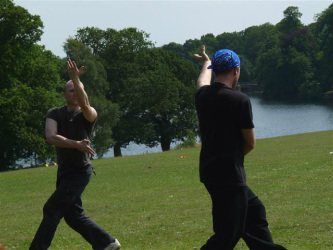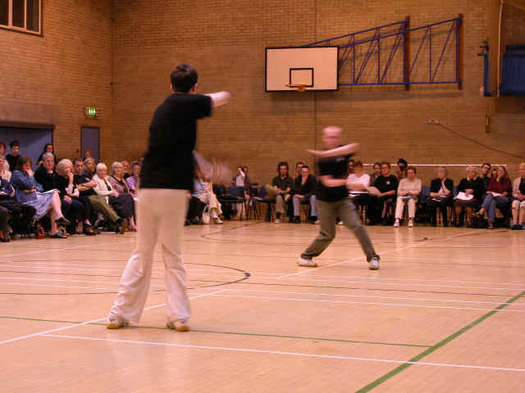Ba Gua Zhang

Ed Hartley and Ben Morris demonstrating spontaneous Bagua, 2011
You can listen to this information while watching our video introduction to Bagua Basics on You Tube.
Ba Gua Zhang (Eight Trigram Palm) is one of the three main Internal Martial Arts in China, the other two being Tai Chi Chuan and Hsing Yi Chuan. Each is a complete system in its own right and yet they share the same principles and, when learned together, complement and support each other.
Bagua (sometimes written as Baguazhang, BaGua or Pa Kua) trains the body to be strong yet very flexible like a coiled rope that can whip around, evading kicks and punches and wriggling free from an opponent’s attempted grip while delivering very powerful strikes with open palms, elbows and other parts of the body or throwing the opponent off-balance. Rapid changes of direction confuse the opponent and increase the chances of surviving an attack by more than one person.
In classical Cheng Ting Hua Bagua, the student begins by learning eight “mother palms” or hand positions while standing in a low stationary posture with a vertical spine and a pronounced twist at the waist. The student then learns to “walk the circle”, beginning with a sixteen-step octagon representing the eight trigrams or Ba Gua. The inner foot always points straight ahead while the outer foot turns in a little to form the corners of the octagon. The circle can later be made bigger or smaller by adjusting the angle that the outer foot turns inward. The steps around the circle begin as tight steps with the thighs together and the student then progresses to “muddy stepping” in which the foot slides out, parallel to the ground.
The eight palms are then practiced while walking the circle and can be combined in innumerable different ways, enabling the student, after a few hundred hours of practice, to move in a fluid and spontaneous manner, twisting and turning, with sudden changes of direction and height, the idea being to move around the opponent, striking powerfully from different angles when an opening presents itself. This spiralling, "dragon-body" motion, characteristic of Bagua and Tai Chi, is very effective in close-contact grappling, in which the whole body is used to unbalance the opponent.
Some palm changes are complex and form sub circles off the main circle, and there may also be short linear sequences at a tangent to the circle. Some schools have studied and developed these linear sequences and studied them exclusively.
At Yiheyuan, we teach circular Chen Ting Hua Bagua, as taught to us by Master Zhu Guang of Beijing, and also the 64 Linear Bagua (eight linear sequences, each containing eight movements) and their applications, from the Beijing Gao family style, as taught to us by Master Nigel Sutton.
For anyone living in the UK and interested in studying Bagua, we provide a range of learning opportunities including private lessons, occasional seminars and home study resources. Some of our Tai Chi classes can accommodate students training in Bagua. If you would like to discuss your training needs and how we may be able to help you, please contact us on [email protected]
For home study, a Bagua DVD and Training Manual are available.
Retun Home

